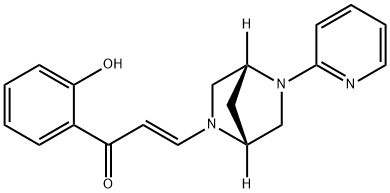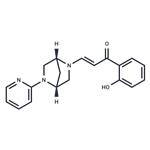Description
PFI-3 (1819363-80-8) is a selective inhibitor of family VIII bromodomains PB1(5), SMARCA2, and SMARCA4.1 It showed complete selectivity over all non-family VIII bromodomains.? PFI-3 blocked adipogenesis in C3H10T1/2 mesenchymal cells at 20μM.Treatment of embryonic stem cells with PFI-3 led to deprivation of stemness and deregulated lineage specificity. Differentiation of trophoblast stem cells in the presence of PFI-3 was enhanced.2 Cell permeable.
Uses
PFI-3 is a selective chemical inhibitor for SMARCA (2/4) and PBI (5) bromodomains which may result in the delay and prevention of breast cancer.
Definition
ChEBI: PFI-3 is an azabicycloalkane that is (1R,4R)-2,5-diazabicyclo[2.2.1]heptane which is substituted at position 2 by a 3-(2-hydroxyphenyl)-3-oxoprop-1-en-1-yl group and at position 5 by a pyridin-2-yl group. It is a potent and selective inhibitor of polybromo 1 (Kd = 48 nM), SMARCA2 and SMARCA4 (Kd = 89 nM) bromodomains. It is a member of pyridines, an azabicycloalkane, a member of phenols and an enone.
Biochem/physiol Actions
SMARCA4 (SWI/SNF related, Matrix associated, Actin dependent Regulator of Chromatin, subfamily A, member 4) is a transcriptional activator and is a component of the large ATP-dependent chromatin remodeling complex SWI/SNF, which is required for transcriptional activation of genes normally repressed by chromatin. SMARC4 (also known as BRG1) and the related protein SMARCA2 (also known as BRM) contain a bromodomain that is structurally similar to the PolyBromo1 (PB1) 5 bromodomain. PFI-3 is a selective chemical probe for SMARCA bromodomains that inhibits SMARCA2, SMARCA4 and PB1(5) bromodomains. For full characterization details, please visit the PFI-3 probe summary on the Structural Genomics Consortium (SGC) website.To learn about other SGC chemical probes for epigenetic targets, visit sigma.com/sgc
References
Gerstenberger et al. (2016), Identification of a chemical probe for family VIII bromodomains through optimization of a fragment hit; J. Med. Chem. 59 4800
Fedorov et al. (2015), Selective targeting of the BRG/PB1 bromodomains impairs embryonic and trophoblast stem cell maintenance; Sci. Adv. 1 e1500723


